Module2 Unit1
Module 2 Unit 1 外研版英语九年级上册知识点详解

外研版九(上)Module 2 Public holidays知识点详解Unit 1 My family always go somewhere interesting as soon as the holiday begins.★(A2).【知识点再现】The First of October is China’s National Day, isn’t it, Lingling? 玲玲,10月1日是中国的国庆节,对吗?【知识点1】the First of October 意为“十月一号”。
英语年月日的表达“在英国英语中,通常可有两种表达法。
以“1988年5月2日”为例:表达法①:写法:(the) 2 (nd) May, 1988;读法:the second of May, nineteen eighty-eight;表达法②:写法:May (the) 2 (nd), 1988;读法:May the second, nineteen eighty-eight。
如:I was born on March 6th, 1990. 我出生于1990年3 月6日。
读成:I was born on March the sixth, nineteen ninety. 或I was born on the sixth of March, nineteen ninety. 【拓展】①写法中,日期与月份之间不可加逗号;②写法中,年份前的逗号可以省略;③写法中,代表日期的序数词词尾(-st,-nd,-rd或-th)均可省略;④写法中,序数词前的定冠词the,一般可省略(尤其是以序数词开头的场合);但在读法中,该定冠词则不省略。
【知识点2】本句是反意疑问句。
在陈述句之后,附加上一个简短问句,对陈述句所述的事情提出相反的疑问,这种疑问句叫作反意疑问句。
反意疑问句由“陈述句+附加疑问句”两部分构成。
反意疑问句的结构有两种:前肯后否;前否后肯。
Module_2_unit_1I've_also_entered_lots_of_speaking_competition_
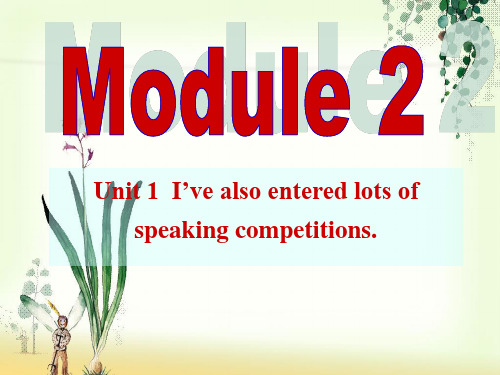
My dream place
I haven’t been to London. I haven’t visited the Tower Bridge.
Eiffel Tower France
I haven’t been to France. I haven’t travelled to Eiffel Tower.
Have you travelled by plane?
Yes, I have.
/No, I haven’t
Have you ever visited Hangzhou?
Yes, I have. I have visited Hangzhou.
Have you ever visited the Great Wall?
future
wash your hands ----- have washed them study for English test ----- have studied for it visit your grandpa ----- have visited him listen to the English tape -----have listened
3. Lingling has travelled / hasn’t travelled
by plane.
Listen and discuss
What king of competition does Lingling enter?
A speaking competition.
Now listen then check (√) what Lingling and Tony have or have not done.
I have visited Hangzhou. I haven’t visited the Great Wall. He has visited Wuzhen. She hasn’t visited Shanghai.
Module_2_Unit_1_can_you_tell_me_where_you_are_from
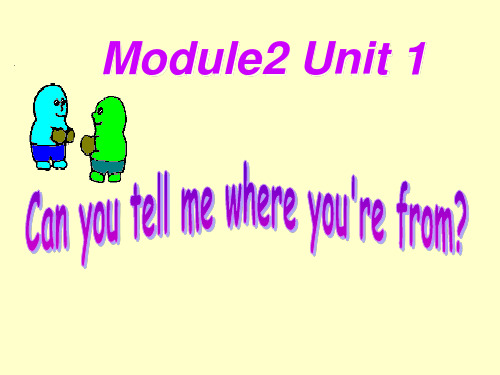
he likes or not . whether / if 2) I want to know__________(是否) she will come.
2. welcome to 欢迎到…来
Welcome tothe Great Wall. eg: __________
3. in fact 实际上 (在句中作状语,常用来强调) eg: He likes sports shows, in fact _________, he prefers game shows.
我是… …在吗?
Why does Sally call Chen Huan? She wants to ask Chen Huan if she can take her friend Lingling to the interview next week.
Listen and answer : Do you know if Sally Maxwell has arrived?
B:Who’s calling, please! C:_______ Sally Mexwell speaking. This is B:_____________________ ? Can I help you C:Yes,please! B:Can you ask Chen Huan if I can bring interview a friend to the _________next week? C: I’msure that would be ok! ______ B: Great ! Thank you ! C: Bye!
Yes, she has arrived.
Can you tell me where Sally is from? Yes, she is from London.
三年级下册英语教案-Module 2 Unit 1《It’s very long》|外研社(一起)

三年级下册英语教案-Module 2 Unit 1《It’s very long》|外研社(一起)一、教学目标1.学习新词汇:–long–short–big–small–heavy–light2.能力目标:–通过听说读写综合提升学生的英语语感–培养学生的观察力、逻辑思维能力和语言表达能力3.情感目标:–激发学生的学习兴趣,培养积极向上的学习态度二、教学内容本单元的主题是“大小重量”,主要包括以下内容:1.新单词的学习:long、short、big、small、heavy和light2.对话练习:通过对话学习如何询问物品的大小、长度和重量3.综合练习:综合运用所学的语言知识和技能三、教学步骤第一步:导入新词汇1.教师出示单词卡片:long、short、big、small、heavy和light,让学生看并重复。
2.将单词卡片放在黑板上,让学生自己组成词组。
3.教师带领学生分别读出每个词组。
第二步:对话练习1.教师通过对话的形式,教授如何询问物品的大小、长度和重量。
2.学生分为两人一组进行对话练习。
第三步:综合练习1.在黑板上画出一些图形,让学生说出每个图形的大小、长度和重量。
2.教师出示几个物品,并让学生分别用新学的词汇描述它们的大小、长度和重量。
3.教师板书一些应用句型,让学生仿写并练习使用。
四、教学重点与难点教学重点1.学习新词汇:long、short、big、small、heavy和light。
2.能够用英语询问物品的大小、长度和重量。
3.能够用英语描述物品的大小、长度和重量。
教学难点1.帮助学生理解数值词和计量单位的使用方法。
2.教会学生如何组织语言表述。
五、教学评价1.监控学生的语音语调是否正确。
2.监控学生的听、说、读、写能力并加以评估。
六、教学延伸1.在此基础上,教师可以通过引入更多词汇和更复杂的对话,进一步培养学生的英语语感。
2.教师可以引导学生使用语言表述图片、视频等多种形式的表现形式,有助于学生的多元思考与创造力的提升。
外研版英语七年级上册Module 2 Unit1 核心词汇讲解

Unit1 核心词汇讲解1.aunt / ɑːnt/ n. 姨母,姑妈,舅母,伯母等。
【例句】This is my aunt, Mona. 这是我姑妈,莫娜。
【拓展】在英语中,比自己长一辈的所有女性亲属,除母亲之外,均可称之为aunt。
aunt的对应词是uncle,后接姓名时,首字母也应大写。
Aunt Mary 玛丽阿姨2.brother / 'brʌðə/ n. 兄弟。
【例句】Jack is his brother. 杰克是他的哥哥。
【拓展】brother意为“兄弟”,与sister相对。
英语中表示“兄(弟)姐(妹)”都没有各自专指的词,一般用brother, sister表示。
在必要时,可以在brother,sister之前加elder表示“兄、姐”,而“弟、妹”的表达法是在brother, sister前加“younger”或“little”。
This is my elder brother.这是我哥哥。
3.cousin / 'kʌz(ə)n/ n.堂兄妹,表兄妹。
【例句】Her mother is my aunt. She is my cousin. 她妈妈是我姑妈,她是我表妹。
【拓展】在英语中,uncle与aunt的孩子都可以成为cousin。
4.family / 'fæmɪlɪ/ n. 家,家庭。
强调整体时,做主语,谓语要用第三人称单数形式。
【例句】My family is a big one. 我们是一个大家庭。
5.father / 'fɑːðə/ n.父亲,爸爸。
father是书面语,口语中常用“dad”。
【例句】Like father, like son. 有其父必有其子。
6.mother / 'mʌðə/ n.母亲,妈妈。
mother是书面语,在口语中常用“mum”或“mom”。
【例句】I love my mother very much. 我很爱我妈妈。
Module-2Unit-1-What-did-you-buy教学设计25
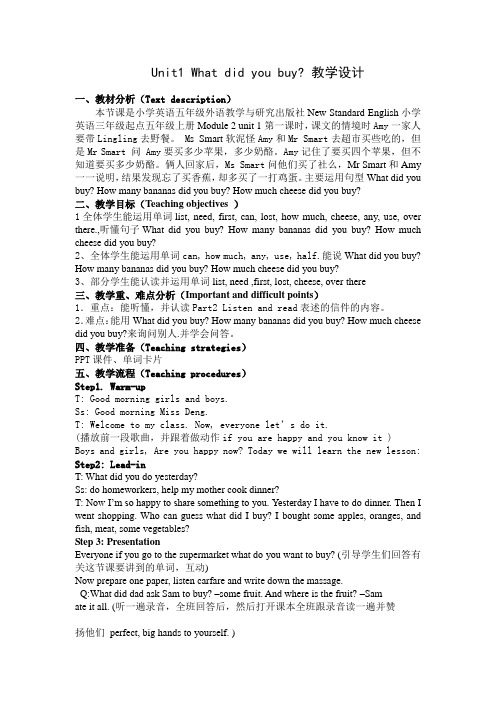
Unit1 What did you buy? 教学设计一、教材分析(Text description)本节课是小学英语五年级外语教学与研究出版社New Standard English小学英语三年级起点五年级上册Module 2 unit 1第一课时,课文的情境时Amy一家人要带Lingling去野餐。
M s Smart软泥怪Amy和Mr Smart去超市买些吃的,但是Mr Smart 问 Amy要买多少苹果,多少奶酪。
Amy记住了要买四个苹果,但不知道要买多少奶酪。
俩人回家后,Ms Smart问他们买了社么,Mr Smart和Amy 一一说明,结果发现忘了买香蕉,却多买了一打鸡蛋。
主要运用句型What did you buy? How many bananas did you buy? How much cheese did you buy?二、教学目标(Teaching objectives )1全体学生能运用单词list, need, first, can, lost, how much, cheese, any, use, over there.,听懂句子What did you buy? How many bananas did you buy? How much cheese did you buy?2、全体学生能运用单词can, how much, any, use, half.能说What did you buy? How many bananas did you buy? How much cheese did you buy?3、部分学生能认读并运用单词list, need ,first, lost, cheese, over there三、教学重、难点分析(Important and difficult points)1.重点:能听懂,并认读Part2 Listen and read表述的信件的内容。
Module 2 unit 1翻译
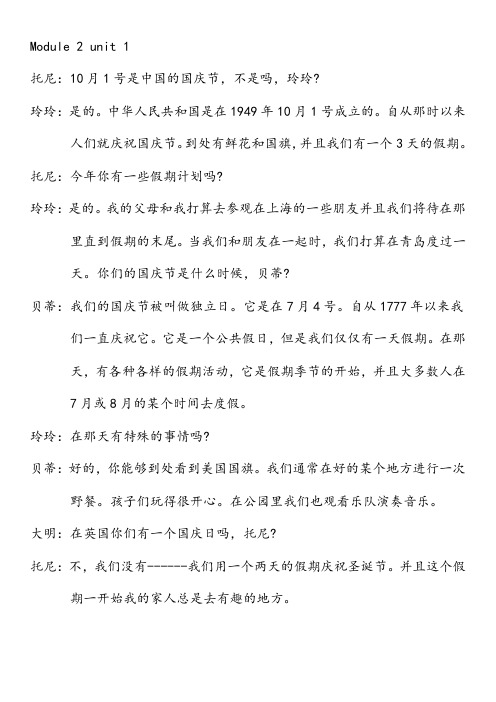
Module 2 unit 1
托尼:10月1号是中国的国庆节,不是吗,玲玲?
玲玲:是的。
中华人民共和国是在1949年10月1号成立的。
自从那时以来人们就庆祝国庆节。
到处有鲜花和国旗,并且我们有一个3天的假期。
托尼:今年你有一些假期计划吗?
玲玲:是的。
我的父母和我打算去参观在上海的一些朋友并且我们将待在那里直到假期的末尾。
当我们和朋友在一起时,我们打算在青岛度过一
天。
你们的国庆节是什么时候,贝蒂?
贝蒂:我们的国庆节被叫做独立日。
它是在7月4号。
自从1777年以来我们一直庆祝它。
它是一个公共假日,但是我们仅仅有一天假期。
在那
天,有各种各样的假期活动,它是假期季节的开始,并且大多数人在
7月或8月的某个时间去度假。
玲玲:在那天有特殊的事情吗?
贝蒂:好的,你能够到处看到美国国旗。
我们通常在好的某个地方进行一次野餐。
孩子们玩得很开心。
在公园里我们也观看乐队演奏音乐。
大明:在英国你们有一个国庆日吗,托尼?
托尼:不,我们没有------我们用一个两天的假期庆祝圣诞节。
并且这个假期一开始我的家人总是去有趣的地方。
五年级上册英语课件-Module-2-Unit-1-What-did-you-buy
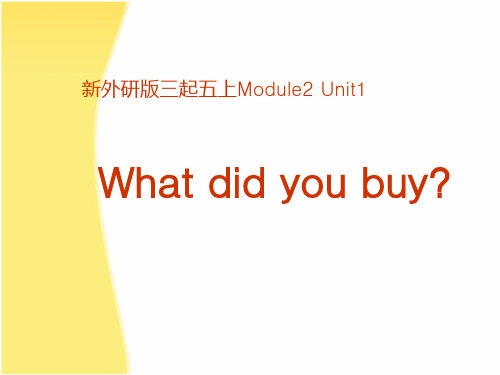
How many bananas did you buy? How much cheese did you buy?
“how many”和”how much”都 是用于询问“多少”的:
“how many”用来提问可数名词的数量 ,
”how much”用来提问不可数名词的数 量。
单词:food, need, cheese, 短语:shopping list, how much 句子: What did you buy? We bought... How many apples did she say? How much cheese did she say?
New words: 1. need 需要 2. food 食物 3. kilo 千克,公斤 4. cheese 奶酪 5. how much 多少 (用于不可数名词) 6. shopping list 购物单
supermarket
Yesterday I we超n市t shopping.
Shopping list
模块句型
• How many… did you • How much…did you
buy?
buy?
• apples • pears • eggs • bananas • watermelons • cakes
• water • meat • milk • cheese • fish • rice
• “how many”和“how much”都是用来询问“多 少”
eggs
meat
How many bananas did you buy? How much cheese did you buy?
How much meat did you buy?
外研版 英语 四年级下册 module 2 unit 1 listen, point 读音

外研版英语四年级下册 module 2 unit 1listen, point 读音在四年级下册的英语教材中,module 2 unit 1中的内容主要包括听力和指认读音。
在这个单元中,学生将通过听音辨认单词和句子,以及通过发音指认相应的图片和单词。
这是一个非常重要的环节,它帮助学生培养正确的英语发音和听力理解能力。
首先,听力是学习英语的重要基础之一。
在这个单元中,学生将通过听音辨认单词和句子。
通过反复听和模仿,他们将逐渐熟悉英语的发音规律,提高他们的听力理解能力。
通过听音辨认单词和句子,学生将能够更好地理解和运用所学的英语知识。
其次,发音指认是帮助学生巩固所学知识的重要方法。
在这个单元中,学生需要根据发音指认相应的图片和单词。
通过这个活动,学生将能够巩固所学的单词和句子,并且加深对英语发音的认识。
通过不断地练习,学生将能够准确地发音,并且能够准确地辨认和运用所学的单词和句子。
除了听力和发音指认,这个单元还为学生提供了一系列的练习材料,帮助他们更好地掌握所学知识。
学生将通过听音辨认单词和句子、指认图片和单词等活动进行练习。
通过这些练习,学生将能够进一步巩固所学的内容,并且提高他们的英语水平。
此外,这个单元还注重培养学生的学习兴趣和积极性。
在学习英语的过程中,学生可以通过听音辨认和发音指认等活动与课堂互动。
通过参与活动,学生将能够更好地理解和运用所学的知识,增强他们对英语学习的兴趣和积极性。
总之,module 2 unit 1中的听力和发音指认对学生的英语学习起到了重要的作用。
通过听音辨认和发音指认等活动,学生将能够提高他们的听力理解能力和英语发音准确性。
通过练习和参与活动,学生将能够更好地掌握所学的知识,并且增强他们对英语学习的兴趣和积极性。
希望学生们能够在这个单元中取得好成绩,更好地掌握英语。
六上M2U1
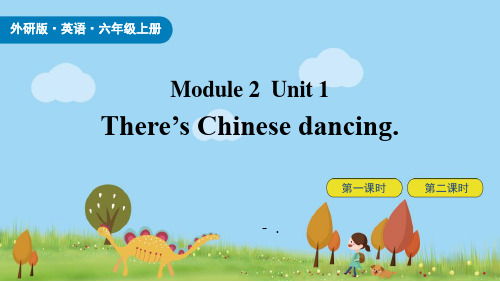
Chinese restaurants
Chinese shops
New words
sh
shop 商店 ship 轮船
shoes 鞋
Chinese dancing
China(中国) + town(市镇)= Chinatown (中国城,唐人街)
foot(脚) + ball(球)= football (足球)
dancing restaurants Then shop Sometimes
1. ——We can't go to the library now. It closes at 5 o'clock. —— Then let's go to the museum.
2. SometimesI miss my cousin in America. 3. I need a pen, so I will go to the shop . 4. We can see Chinese dancing in Chinatown. 5. I am hungry. Are there any restaurants ?
There is a map.
There is a basketball.
There are five apples.
There are four monkeys.
There are five books.
Listen and find out “There be…”
Simon: What are you doing, Daming?
Daming misses China. Simon will take him to Chinatown.
Watch and listen.
Module 2 Unit1 外研版九年级上册英语
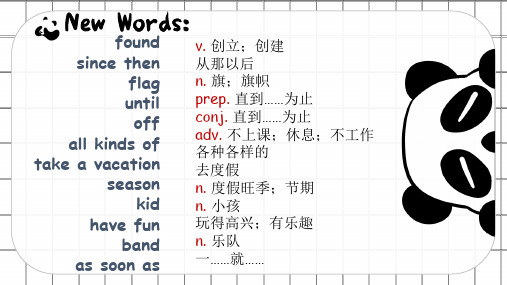
on the first Monday in September .
Tony and his friends are talking about something. Let’s listen and find out what they are talking.
3. Listen and choose.
have seven days off =have a seven-day holiday
We have a seven-day holiday during
.
What public holidays do you know about China? How many days off do we have?
??
IItt’’ss MAparyilththeefiffotuhr.th.
It’s the fourth of April. It’s the fifth of May.
WWhehnenisisththee
?? ?
IItt’’ss DOecctoembebretrhtehfeir2s5t.th. IItt’’ssIItttt’’hhsseetJh2fuie5rltsyfhtotuoohrffetODhfoceoutcfoerbJmthuebr.ly.e.r.
kid n. 小孩
have fun 玩得高兴;有乐趣
band as soon as
n. 乐队 一……就……
Module 2 Public Holidays
Yoyo
What public holidays do you know about China? How many days off do we have?
去e ve要用f替,ty要变tie 遇到几十几,变个位数就可以
新外研版四年级上册 Module 2 unit 1
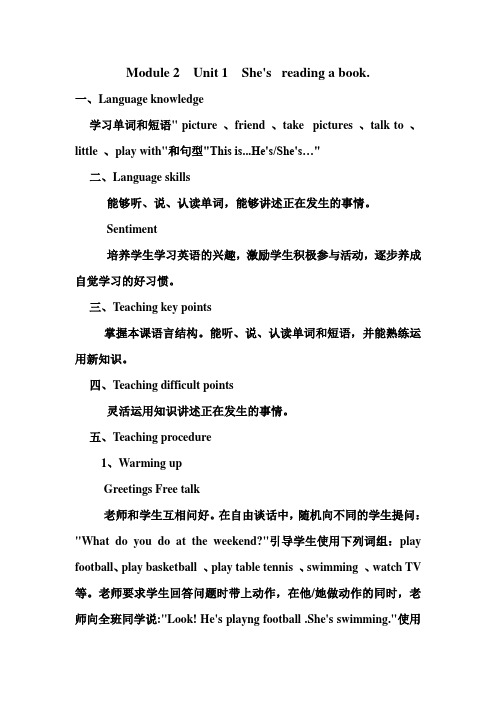
Module 2 Unit 1 She's reading a book.一、Language knowledge学习单词和短语" picture 、friend 、take pictures 、talk to 、little 、play with"和句型"This is...He's/She's…"二、Language skills能够听、说、认读单词,能够讲述正在发生的事情。
Sentiment培养学生学习英语的兴趣,激励学生积极参与活动,逐步养成自觉学习的好习惯。
三、Teaching key points掌握本课语言结构。
能听、说、认读单词和短语,并能熟练运用新知识。
四、Teaching difficult points灵活运用知识讲述正在发生的事情。
五、Teaching procedure1、Warming upGreetings Free talk老师和学生互相问好。
在自由谈话中,随机向不同的学生提问:"What do you do at the weekend?"引导学生使用下列词组:play football、play basketball 、play table tennis 、swimming 、watch TV 等。
老师要求学生回答问题时带上动作,在他/她做动作的同时,老师向全班同学说:"Look! He's playng football .She's swimming."使用这种方法呈现更多新语言。
2、Presentation学习单词、短语。
老师釆用“温故而知新”的方法教授新单词和短语。
例如:white-write 、lake-take 、walk-talk。
让学生自己先试着读,然后结合图画熟练掌握新单词和短语。
3、Learn the text请学生仔细观察图画,认真阅读课文,帮助学生弄清楚故事内容和情节:Sam正在展示自己的绘画作品,其中有Lingling写信的画,Daming照相的画,Amy打电话的画,还有Tom玩玩具火车的画。
五年级英语上册课件-Module 2 Unit 1 (1)-外研版(三起)
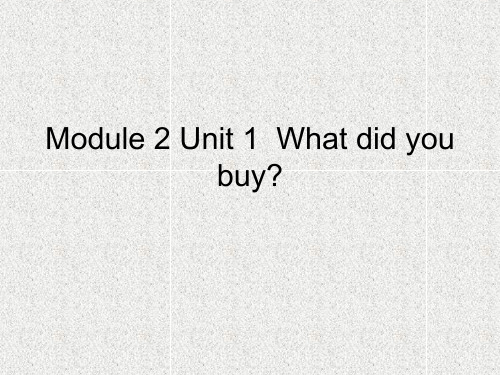
food
• Do you like…? • Yes, I do.
No, I don’t. I like…
Question:
Why do Lingling and Ms. Smart go to the supermarket?
need
需要
shopping
购物Biblioteka Shopping list
(购物单)
What have you learnt in this class?
• 单词:food, need, cheese, kilo 短语:shopping list, how much 句子: Do you like…? Yes, I do. / No, I don’t.
• How many... do you want? Six, please. • How much… do you want? Half a kilo.
奶酪
cheese
奶酪是一种发酵的牛奶制品,其性质
与常见的酸牛奶有相似之处,都是通过发 酵过程来制作的,也都含有可以保健的乳 酸菌,但是奶酪的浓度比酸奶更高,近似 固体食物,营养价值也因此更加丰富。每 公斤奶酪制品都是由10公斤的牛奶浓缩而 成,含有丰富的蛋白质、钙、脂肪、磷和 维生素成分,是纯天然的食品。就工艺而 言,奶酪是发酵的牛奶;就营养而言,奶 酪是浓缩的牛奶。
• 找出课文中含有how many how much 的句子。
找出两组句子的相同与不同之处
• A组: • How many apples do you want? • How many books do you want? • How many oranges do you want? • B组: • How much rice do you want? • How much cheese do you want? • How much milk do you want?
Module 2 Unit 1 There's Chinese dancing.(教学设计)外研版

Unit 1 There's Chinese dancing.教学设计一、教材分析:本节课是外研版(三起)小学英语六年级上册Module2 Unit 1的教学内容,主题为"There's Chinese dancing." 本单元主要围绕介绍中国传统舞蹈展开,通过听、说、读、写等多种方式,培养学生的英语听说能力和文化意识。
二、教学目标:1. 听:能听懂并理解有关中国传统舞蹈的基本信息。
2. 说:能运用所学句型和词汇进行简单的口头表达,描述中国传统舞蹈。
3. 读:能读懂并理解与中国传统舞蹈相关的简短文章。
4. 写:能根据所学内容,用简单的句子描述中国传统舞蹈。
5. 文化意识:了解中国传统舞蹈的特点和重要性,培养对不同文化的尊重和欣赏能力。
三、教学重点和教学难点:教学重点:学习和掌握与中国传统舞蹈相关的词汇和句型,培养听说读写的综合能力。
教学难点:运用所学知识进行简单的口头表达和书面表达。
四、学情分析:学生是六年级的学生,已经具备一定的英语基础,能够进行基本的英语交流。
他们对中国传统文化可能有一定的了解,但对中国传统舞蹈的具体内容和特点可能还不太清楚。
他们具备一定的学习能力和接受新知识的能力。
五、教学过程:Step 1: Warm-up (热身)1. Greeting and daily check-in (问候和日常签到)-Greet the students and do a quick check-in to see how they are doing.- Example dialogue:Teacher: Good morning, everyone! How are you today?Students: Good morning, teacher! We're fine, thank you!2. Review of previous knowledge (复习)-Review the vocabulary and sentence patterns related to describing places and activities.-Use flashcards or pictures to review the words and ask questions to check their understanding.- Example:Teacher: Let's review some words we learned before. What's this? (Showing a picture of a park)Student: It's a park.Teacher: Great! And what do we say when we want to describe a park?Student: There is a park.Step 2: Presentation (呈现)1. Introduce the topic (介绍话题)-Show pictures or videos of Chinese traditional dancing, such as the dragon dance or the lion dance.- Example dialogue:Teacher: Today, we are going to learn about Chinese traditional dancing. Look at these pictures. Have you ever seen Chinese traditional dancing before?Students: Yes/No.Teacher: Chinese traditional dancing is very colorful and lively. It's an important part of Chinese culture.2. Present new vocabulary (呈现新词汇)-Introduce new vocabulary related to Chinese traditional dancing, such as "Chinese dancing," "dragon dance," "lion dance," etc.-Use real objects, pictures, or gestures to help students understand the meanings of the words.- Example:Teacher: This is a dragon. In Chinese traditional dancing, people perform the dragon dance. Can you repeat "dragon dance"?Students: Dragon dance.3. Introduce the sentence pattern (介绍句型)- Introduce the sentence pattern "There's Chinese dancing."-Explain the meaning and structure of the sentence pattern.- Model the sentence pattern and ask students to repeat.- Example:Teacher: Now, let's learn a sentence pattern. Repeat after me: "There's Chinese dancing."Students: There's Chinese dancing.Step 3: Practice (练习)1. Listening practice (听力练习)- Play an audio recording or video about Chinese traditional dancing.- Ask students to listen and answer questions related to the audio or video.- Example:Teacher: Listen to the audio and answer this question: What kind of dancing did you hear/see?Students: Dragon dance.2. Speaking practice (口语练习)- Divide the class into pairs or small groups.-Ask students to discuss and share their thoughts about Chinese traditional dancing.-Encourage them to use the sentence pattern and new vocabulary they have learned.- Example:Teacher: Now, I want you to work in pairs and talk about Chinese traditional dancing. Use the sentence pattern "There's Chinese dancing" and the vocabulary we learned. Take turns to ask and answer questions.Student A: Is there Chinese dancing in your country?Student B: No, there isn't. But I've seen the dragon dance during Chinese New Year celebrations.3. Reading practice (阅读练习)- Distribute reading passages or worksheets about Chinese traditional dancing.- Ask students to read the passages individually or in pairs.-Guide them to identify key information and answer comprehension questions.- Example:Teacher: Read the passage silently and answer the questions on your own. Then, discuss your answers with your partner.Students: Read the passage and answer the questions. 4. Writing practice (写作练习)- Ask students to write a short paragraph or a few sentences to describe Chinese traditional dancing.-Provide a writing prompt or a template to guide their writing.-Encourage them to use the sentence pattern and vocabulary they have learned.- Example:Teacher: Imagine you are writing a postcard to your friend. Write a few sentences to describe Chinese traditional dancing. Start with "There's Chinese dancing" and include some details about the dragon dance or the lion dance.Step 4: Consolidation (巩固)1. Class discussion (课堂讨论)- Lead a class discussion about Chinese traditional dancing.-Encourage students to share their opinions, experiences, and what they have learned.- Ask open-ended questions to stimulate their thinking andencourage active participation.- Example:Teacher: Who would like to share their thoughts on Chinese traditional dancing? What do you find interesting about it?2. Cultural awareness (文化意识)-Discuss the importance of preserving and appreciating traditional dances in different cultures.-Compare Chinese traditional dancing with traditional dances from other countries.-Encourage students to respect and appreciate cultural diversity.- Example:Teacher: Chinese traditional dancing is an important part of Chinese culture. Can you think of any traditional dances from other countries? How are they similar or different from Chinese traditional dancing?Step 5: Wrap-up (总结)1. Review the key points (复习要点)-Summarize the key vocabulary, sentence patterns, and cultural knowledge covered in the lesson.- Ask students to repeat the words and sentence patterns.- Example:Teacher: Let's review what we have learned today. Repeat after me: Chinese dancing, dragon dance, lion dance, There's Chinese dancing.2. Homework assignment (布置作业)-Assign homework tasks, such as writing a short essay about their favorite traditional dance or researching more about Chinese traditional dancing.-Provide clear instructions and deadlines for the homework.- Example:Teacher: For homework, I want you to write a short essay about your favorite traditional dance. You can choose Chinese traditional dancing or a traditional dance from your own culture. Include some details about the dance and why you like it. The essay should be at least 100 words.六、板书设计:Title: Module 2 Unit 1 - There's Chinese dancing. Vocabulary: Chinese dancing, dragon dance, lion dance, etc. Sentence Pattern: There's Chinese dancing.七、教学反思:以上教学过程中,通过多种方式(如图片、视频、听力、口语、阅读、写作)让学生全方位地了解和学习中国传统舞蹈。
最新六年级上册外研英语Module 2Unit1 教案

Module 2 Unit 1 I went to Chinatown in New York yesterday.教材分析本课是六年级上册第二模块第一单元。
话题是过去的活动,主要语言功能是运用过去时来描述过去的经历。
Unit1的课文情境是Daming在给妈妈写电子邮件,他在邮件中写到自己昨天去了唐人街。
唐人街上到处都是中国人,有许多中国商店和中餐馆,人们讲英语,也讲汉语。
他和Simon中餐馆吃了饭,发现唐人街的中餐和中国国内的中餐有些不同. 然后他们在街上看了舞狮表演,Simon非常喜欢,他很想到中国学汉语,看长城。
本课的重点是让学生对唐人街有所了解,并运用一般过去式来写电子邮件。
学情分析①学生有一定的操作电脑的基础,对教师的指令基本正确的进行操作。
②学生有一定合作意识,能够互帮互助。
③本课采取了活动、游戏等能激发学生的兴趣,调动了学生的积极性,使学生在真实的情境中学习,感受所学的知识,并真正地把它运用到实际中。
教学目标语言知识功能:介绍自己过去的经历语法:复习一般过去式,全体学生能运用:I went toChinatown in new York yesterday.词汇: 全体学生能理解: Chinatown, town, subject,everywhere ,spoke, lion dance 。
全体学生能运用: spoke , road 。
部分学生能运用: Chinatown , town , subject ,everywhere , lion dance。
语音: 巩固已学语音,进一步强化尚存在困难的语音。
语言技能听:全体学生能听懂:I went to Chinatown in new Yorkyesterday.说:全体学生能说:I went to Chinatown in new Yorkyesterday.读:全体学生能朗读课文,阅读相关的短文写:全体学生能拼写3到4个自选单词;在老师的帮助下,借助图片和关键词,部分学生能用一般过去时态写出自己过去的经历。
Module-2-Unit-1-There’s-Chinese-dancing
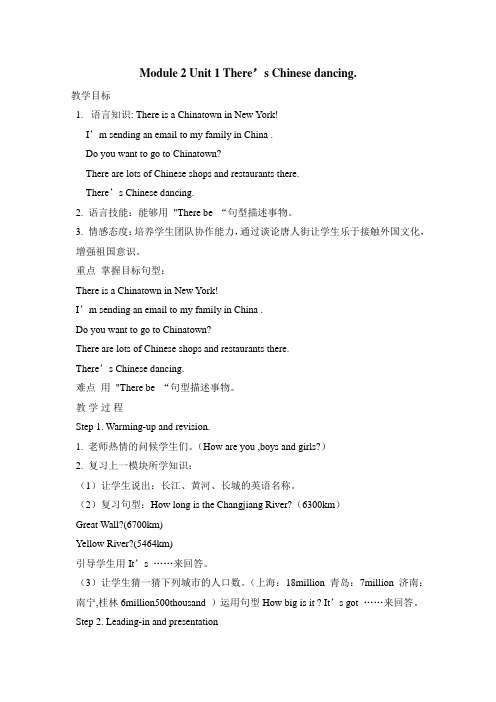
Module 2 Unit 1 There’s Chinese dancing.教学目标1.语言知识: There is a Chinatown in New York!I’m sending an email to my family in China .Do you want to go to Chinatown?There are lots of Chinese shops and restaurants there.There’s Chinese dancing.2. 语言技能:能够用"There be “句型描述事物。
3. 情感态度:培养学生团队协作能力,通过谈论唐人街让学生乐于接触外国文化,增强祖国意识。
重点掌握目标句型:There is a Chinatown in New York!I’m sending an email to my family in China .Do you want to go to Chinatown?There are lots of Chinese shops and restaurants there.There’s Chinese dancing.难点用"There be “句型描述事物。
教学过程Step 1. Warming-up and revision.1. 老师热情的问候学生们。
(How are you ,boys and girls?)2. 复习上一模块所学知识:(1)让学生说出:长江、黄河、长城的英语名称。
(2)复习句型:How long is the Changjiang River?(6300km)Great Wall?(6700km)Yellow River?(5464km)引导学生用It’s ……来回答。
(3)让学生猜一猜下列城市的人口数。
(上海:18million 青岛:7million 济南:南宁,桂林6million500thousand )运用句型How big is it ? It’s got ……来回答。
- 1、下载文档前请自行甄别文档内容的完整性,平台不提供额外的编辑、内容补充、找答案等附加服务。
- 2、"仅部分预览"的文档,不可在线预览部分如存在完整性等问题,可反馈申请退款(可完整预览的文档不适用该条件!)。
- 3、如文档侵犯您的权益,请联系客服反馈,我们会尽快为您处理(人工客服工作时间:9:00-18:30)。
1.Tom is listening to the music. (划提 划提) 划提 ______ is listening to the music? ? 2. My mother is working. (划提 划提) 划提 ________ is working? 3. She is cleaning the house. (划提 划提) 划提 ______ is _______ ________? 4. They are working. (划提 划提) 划提 ______ ______ _______ _______? 5.Daming is lying in the sun. (划提 划提) 划提 ______ ______ Daming ________?
Now listen and check.
1. Cleaning the house 2. Cooking the meal 3. Getting ready for Spring Festival 4. Learning a dragon dance 5. Making lanterns 6. Sweeping the floor (5) (4 ) ( ) ( 1) (2 ) (3 )
1.Tom is listening to the music. (划提 划提) 划提 ______ is listening to the music? ? 2. She is cleaning the house. (划提 划提) 划提 ______ ______ is ________? 3. They are working. (划提 划提) 划提 ______ ______ _______ _______? 4.They are sleeping now. (划提 划提) 划提 ______ are they sleeping ? 5. People are drinking in the pub. _______ are People drinking ?
learn a dragon dance They’re learning a dragon dance.
sweep the floor They’re sweeping the floor.
What are they doing?
cook a meal She’s cooking a meal.
4.They are sleeping now. (划提 划提) 划提 ______ are they sleeping ? 5.She is doing her homework at home. ______ is she doing her homework ? 6. People are drinking in the pub. _______ are People drinking ? 7. They are singing at this moment. _______ are they singing?
Listen and read
P8-2 P8-
拓展延伸
一、将下列短语译成英语 扫地 为……做准备 春节 打扫房屋 做饭 在工作 二、汉译英 1、李磊,发生了什么事? 2 、你正在为明天的考试做准备吗? 3、我父亲正在学舞龙。 4、你会做灯笼吗? 5、我妈妈经常在周末打扫房屋。
根据中文,背诵课文: 根据中文,背诵课文:
Homework 根据课文内容完成P9-3、4部分 根据课文内容完成 、 部分
Question: What are they talking about?
听对话回答以下问题: 听对话回答以下问题:
1. How many people are there in the dialogue? Three. 2. How many people are there in Lingling’s family? Five. 3. What are Lingling and her mother doing ? They’re getting ready for the Spring Festival. 4. Where is Lingling’s father? He’s at work.
What are they doing?
make lanterns They’re making lanterns.
are you What is she boys doing? are the they clean the house shop for Spring Festival They are I She is are… am They make dumplings learn a dragon dance make lanterns cook a meal sweep the floor
回顾现在进行时的概念构成和用法。 英语课代表领读单词(festival ___at work) 听写单词 自主学习 自读课文,在文章中找出下列短语并划线 怎么了 为……做准备 学舞龙 制作灯笼 打扫房间 扫地 做饭 在工作
语法复习(现在进行时) 语法复习(现在进行时)
1. I_________(do) my homework now. 2.She__________(lie) in the sun at the moment. 3.Look! The boy_________(run). 4. What is your mother doing? She___________(put) on her dress. 5.______they________(have) a good time?Yes, they________.
What are they doing?
clean the house They’re cleaning the house.
shop for Spring Festival They’re shopping for Spring Festival.
What are they doing?
make dumplings They’re making dumplings.
6.Tom is listening to the music.(改为 改为 否定句) 否定句 Tom ______ _______ to e music. 7.I write postcard(用now 改写 改写). 用 I ______ _________ postcard. 8.We are enjoying our school trip a lot.(一般问 一般问) 一般问 _____ ______ _______your school trip a lot? No, we__________.
Module 2 Spring festival
Unit 1 We’re getting ready for Spring festival
教学目标
1、学习、理解本单元的新单词、短语:get ready for Spring Festival happen learn dragon dance lantern clean help sweep floor cook meal at work 等, 掌握他们的基本含义和用法,并能准确的加 以运用。。 2、 学习、理解和掌握现在进行时的一般疑问句的肯定和否定回答, 并能准确地加以运用。 3、能听懂有关春节话题的讨论,并了解大意,,从中获取主要信息。 4、通过这一单元有关春节话题的要论和学习,让学生深刻了解这一 节日的文化内涵,培养学生的爱国主义情感。 教学重点:掌握本单元的单词和短语,并能准确的加以运用。 教学难点:掌握现在进行时的一般疑问句的肯定和否定回答,并熟 练运用。
林玲你好。怎么了 你正在为春节做准备吗 你正在为春节做准备吗? 林玲你好。怎么了?你正在为春节做准备吗? 是的。 是的。 男孩们正在做什么? 男孩们正在做什么? 男孩们正学习舞龙。 男孩们正学习舞龙。 你也在学习舞龙吗? 你也在学习舞龙吗? 我没有。我在做灯笼。 不,我没有。我在做灯笼。 你的妈妈正在做什么? 你的妈妈正在做什么? 她正在打扫房间。 她正在打扫房间。 那你的阿姨在做什么?她在帮忙吗? 那你的阿姨在做什么?她在帮忙吗? 是的。她正在扫地。 是的。她正在扫地。 你的奶奶正在做什么? 你的奶奶正在做什么? 她正在做饭。 她正在做饭。 你的爸爸在帮忙吗? 你的爸爸在帮忙吗? 他没有。他正在上班。 不,他没有。他正在上班。
